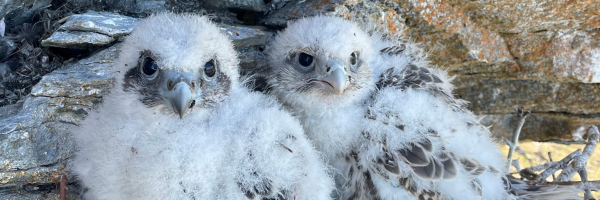Photo by Kara Beer
The Peregrine Fund’s Gyrfalcon & Tundra Conservation Program just wrapped its 10th year of fieldwork in western Alaska studying the effects of climate change on Gyrfalcons and other Arctic raptors. Climate change is among the most pressing conservation concerns of our time, and the accelerated changes in the Arctic provide a fleeting opportunity to understand the complicated impacts on raptor communities. This field season, the team noted that raptor occupancy and breeding success were lower than average.
Through a partnership with the Alaska Department of Fish and Game (ADF&G), our field crew performs helicopter surveys to scan large areas for raptor presence and breeding (ADF&G’s Travis Booms pictured below with Kara Beer and Mike Henderson in front of helicopter). These long-term data are essential for understanding the effects of climate change and represent the only effort of this caliber to understand population trends for Arctic raptors within America. In June 2024, the team observed around 20% fewer Gyrfalcons and Common Ravens with nestlings (Gyrfalcon nestlings pictured below), 50% fewer Golden Eagles and Rough-legged Hawks with nestlings, and 30% fewer Peregrine Falcons with nestlings. Willow and Rock Ptarmigans, important food sources for Arctic raptors, numbered higher than ever documented during our research—about 75% above average for Willow Ptarmigan. Generally, an increase in prey availability results in higher breeding success for raptors, but that trend was not documented this year.
“Heavy rains during nestling rearing likely contributed to low breeding success but lingering effects of Highly Pathogenic Avian Influenza could have also played a role,” says Gyrfalcon & Tundra Conservation Program Manager Mike Henderson.“This summer proved to be among the wettest on record for the region and climate predictions strongly suggest these wet seasons are likely to become more common.” While Alaska’s breeding season was subpar, researchers in Iceland documented at least a 45% decline in breeding Gyrfalcons since 2019, again citing weather and Avian Influenza as likely drivers of decreased breeding success and population size, respectively. This rapid decline highlights the importance of our research efforts to preemptively understand the effects of climate change, including changing diseases and weather patterns.
To understand the impacts of changing weather, Mike’s dissertation—advised by Boise State University (BSU) professor Dr. Jen Cruz—looks into how weather patterns affect Gyrfalcon nestling survival, adult survival, and Arctic raptor community dynamics. They also co-authored a paper to be released by the Journal of Raptor Research in September titled, “Gyrfalcon Disease Ecology: A Survey Across Western Alaska.” This paper details the current state of Gyrfalcon disease ecology but understanding the Gyrfalcon’s vulnerability to novel disease is the other critical component since climate change is bringing new disease to the Arctic.
In collaboration with our team, BSU professor Dr. Stephanie Galla and master’s student Sage Dale (pictured below, left) are looking at Gyrfalcon genetics to understand their ability to adapt to these new diseases. Sage’s research focuses on understanding the Gyrfalcon’s immune system response and how it compares to that of the Peregrine Falcon. Given the wider distribution and disease exposure of the Peregrine Falcon compared to the Gyrfalcon, Sage hypothesizes that Gyrfalcons will have less diversity in genes responsible for fighting diseases when compared to peregrines. Dr. Galla and Sage were central components of the Arctic field crew this year, and their expertise in genetics is an extremely valuable asset for our team.
This season’s field crew was led by Kara Beer (pictured above right) who transitioned from a 2023 Field Technician to the 2024 Crew Lead. “Kara has become an important component of the work for the Gyrfalcon Program,” says Mike. “She is a great asset for our program, The Peregrine Fund, and Arctic raptor conservation as a whole, and we are fortunate to have her on our team.”
The Arctic is already experiencing noticeable impacts of climate change through altered weather patterns, food availability, ecosystem dynamics, and landscape structure. Our Gyrfalcon and Tundra Conservation Program team endures rough terrain, unpredictable weather, and grueling field days to collect data which lay the groundwork for science-informed conservation in light of continued climate change.









